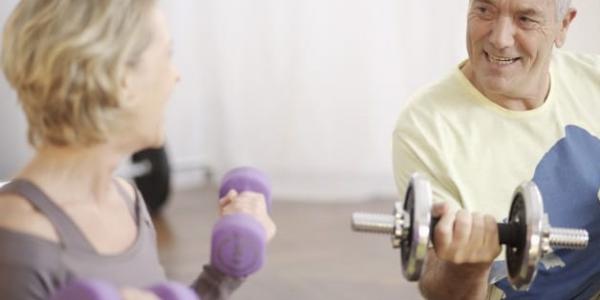Strength Training: Lift Your Way to Better Health

If your workout doesn’t include strength training, you’re missing out. Strength training can ward off age-related muscle loss, keep your bones strong, promote mobility and function, and even help combat depression and cognitive decline.
Physical activity is fundamental to building a healthy body. The Centers for Disease Control concurs, and recommends adults engage in at least 150 minutes of physical activity each week. For many people activities like running, walking, swimming, cycling or gardening are preferred when striving towards that 150-minute weekly goal. These are all great options, but there is a major component of physical activity that about 80% of Americans overlook, and to our detriment: strength training. Strength Training is a method of improving muscular strength by gradually increasing the muscle’s ability to resist force. This is accomplished by using free weights, machines, or the person’s own body weight.
It’s true, strength training has some baggage- and maybe that contributes to a bit of trepidation. For some folks, feeling uncomfortable around other gym patrons is a real thing. For others, it may be unfamiliarity with weight machines that resemble medieval torture devices. Whatever the reason, it can be easy to skip the weight area altogether and opt instead for a cardio-based workout on the treadmill or in the pool. But the truth is, muscle-strengthening exercise is essential, especially as we get older. Everyone (not just athletes and bodybuilders) benefits from strength training. If it’s not a part of your health and fitness routine, you should consider adding it- here’s why:
For starters, strength training helps combat the natural loss of muscle mass and strength that occurs as we age, called sarcopenia. Sarcopenia is natural- in fact after age 30, humans tend to lose between 3% -5% of our muscle mass every decade. The resulting loss of muscular structure can worsen the severity of existing chronic conditions, and is a main cause of functional decline in older adults- which often leads to loss of independence. Fortunately regular resistance training can help halt the effects of sarcopenia, even in older adults who have not previously strength trained.
Functionally, there is major benefit in adopting a regular resistance-training program. Strength training improves posture, balance, bone density, connective tissue strength, and joint function. Improving these systems will ultimately lead to the ‘big picture’ benefit: the ability to confidently and safely perform day-to-day physical tasks as we age. Things like carrying groceries, picking up a grandchild, or climbing a flight of stairs all become easier when we are stronger. Chronic conditions become more manageable as well. Strength training is effective in mitigating the symptoms of conditions like arthritis, back pain, heart disease, depression and diabetes. Oh yeah, and it may contribute to living longer.
While it is clear that there are numerous benefits to be gained from starting a strength program, knowing just how to get started can be mysterious. Use the guidelines below to inform your training:
Training Methods
There are a few options when choosing how to apply resistance to a muscle, and subsequently where you may choose to train:
Body weight: The use of one’s own body weight to apply resistance to a target muscle. Some of the most effective body weight exercises can be performed with little or no equipment, so they are great choices for home workouts (but they’re still just as effective when done in the gym). Some of the cornerstone exercises are pushups, pullups, situps, squats, and dips.
Free weights: Dumbbells, barbells, and kettlebells are staples for their ease of use, versatility and effectiveness. May be used in a gym setting or at home.
Weight machines: Most fitness centers offer a plethora of resistance machines. Gym staff can show you how to use these devices safely. You can also purchase weight machines for home use, although their functionality is usually lower than that of commercial machines found in gyms.
Resistance tubing: Resistance tubes are inexpensive, lightweight rubber bands with handles attached to the ends, which provide resistance when stretched. There are many options available in nearly any sporting goods store. Great choice for home, the office, or when traveling.
Training Frequency
Two days per week is the recommendation, although you may choose to train more than two days. Just give yourself a day or two to recover before working that muscle group again.
A single training bout can last anywhere from 20-40 minutes, and the focus should be on working the six muscle groups. The six groups are: shoulders, chest, back, arms, core, and legs. You may choose to break up your training so that you work three muscle groups per session, hitting each group once per week. An example might be to work the back, arms, and legs on Tuesday, then chest, shoulders, and core on Thursday.
How much resistance/weight should I use?
Start conservatively by warming up with light resistance, enough to comfortably perform 15-20 repetitions. Once you are warm, pick a resistance level that will allow you to lift 12-15 repetitions. Two or three sets of 12-15 repetitions is a good benchmark, although some evidence suggests one set of 12-15 reps performed with good form is just as effective as adding more sets. Focus on quality rather than quantity.
How do I perform the exercises?
Utilize this online tool from the Mayo Clinic. The site describes exercises for each muscle group, including pictures and form cues.
https://www.mayoclinic.org/healthy-lifestyle/fitness/multimedia/weight-training/sls-20076904
Tips for safe strength training:
Control the Weight: Avoid using resistance so heavy that you need momentum to lift it. A simple gauge: You should be able to hold a ‘controlled pause’ for one second in the middle of the repetition.
Stand Up Straight: Want an easy way to tell if you’re performing your exercises correctly? Check your posture. The correct starting position for most exercises is shoulders back, chest out, core engaged, and standing (or sitting) tall. Good posture = good form.
Embrace the Dumbbell: You will not need a spotter, you will rarely have to wait for a pair, and they'll work your muscles harder than machines via proprioception.
*If you have a chronic health condition or haven’t been especially active lately, you should consult your doctor before starting an exercise program.*
https://www.sciencedaily.com/releases/2016/04/160420090406.htm
http://care.diabetesjournals.org/content/28/3/662.short
https://www.ncbi.nlm.nih.gov/pubmed/14552938
https://www.mayoclinic.org/healthy-lifestyle/fitness/in-depth/strength-training/art-20046670
Related Articles

Want a better night’s sleep? Get Moving!
The connection between exercise and sleep is very real. This article examines current research, and how your everyday activities may be influencing sleep patterns.
.jpg)
Physical Literacy: The Foundation for a Life of Movement
Early development of physical literacy is linked to future success in sport and activity participation. In the long run, establishing active habits in children sets them on the path to happier and healthier lives.

Bend, Not Break: The Importance of Maintaining Flexibility
You may not think about it often, but flexibility impacts our everyday lives. Learn more about the physiology of flexibility and why you should consider making stretching part our your routine.

A Brief Guide to the Body's Aerobic System
Aerobic exercise is a cornerstone of physical wellness. Learn more about the function of the aerobic system and the role it plays in supporting good health.





